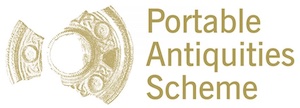NMGW-C2EEE6: Axe
Dating
Bronze Age 2200BC - 1800BC

Image courtesy The Portable Antiquities Scheme
Early bronze age bronze butt fragment from an axe of uncertain type but of flat or developed axe form
the axe is represented by a butt fragment only, broken at one end in antiquity (with a surviving length of 50.2mm and a weight of 51.0g). the butt end is evenly rounded (with a width of 20mm and a thickness of 0.9mm). the sides are straight and divergent for their lengths to the break (where the axe has a width of 28.0mm and a thickness of 8.6mm). the axe butt has a near-rectangular body section, with one face flatter across its width than the other. there is no suggestion of flanges present on the fragment. the corroded surface is heavily-pitted with a dark-green patina and areas of pale-green corrosion and surface loss. . the surface condition and patina suggest a bronze rather than copper composition, although it has not been possible to analyse the composition.
the fragmentary nature of the axe makes typological identification difficult and uncertain. the slender, rounded butt form, absence of flanges and the presumed bronze composition would be consistent with axes of needham’s type 3 and in relation to schmidt and burgess (1981)[1] typology may have been of migdale, aylesford or allied types. axes of these types are likely to be date to the early bronze age, perhaps between c. 2200 – 1800bc.
[1] schmidt, p.k. & burgess, c. 1981; the axes of scotland and northern ireland, praähistorische bronzefunde abteilung ix, 7. band 7
Location
- Region: Wales
- County: Powys
- District: Powys
- Parish: Talgarth




